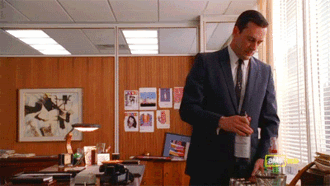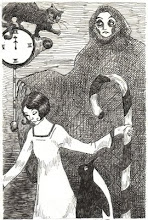
I've caught a couple of shows on their final performances, so unhappy readers, you missed out. But I still wanted to get my two cents in, so hence, this post.
It's really not of Trick Boxing's doing that the pre-show turned into an inadvertent reunion of friends from Fringes past (and present), but I must thank them for it all the same. It felt like 1999 all over again out there in the audience.
The show itself is both as sweet and ephemeral as spun sugar. The story is that ancient boxing chestnut: poor boy, smooth talking manager, wicked gambler, sweet girl. In other words, seen it a hundred times before, nothing special. What elevated the show a bit above the fray was the dancing, which was, in a word, glorious. Brian Sostek plays all the male characters and morphs between them seemingly effortlessly (note: it's pretty much a rule of thumb in theater, that whenever one says something is done "effortlessly", something like a hundred hours of rehearsal and countless more of experience has made it seem so). He also acts as puppeteer and ring announcer for all the bouts. But back to the dancing. Both Sostek and Megan McClellan (who plays the girl), dance beautifully, and with joy. He has that old fashioned, low to the ground grace that is more than rare in this selfish show boat-y age. What I mean is, they both let each other shine, and thus achieve something like grace. The story is really just an excuse for the performers to show off their skills. As considerable as those skills are, this particular reviewer cannot exist on a diet of ice cream sundaes, and would love to see these two marrying their talents to a piece with maybe a shade more originality.
Trick Boxing
Sossy Mechanics
Writer: Megan McClellan and Brian Sostek
Director: Megan McClellan and Brian Sostek
Choreographer: Megan McClellan and Brian Sostek
As I was leaving the theater after the final performance of Butterfly, Butterfly, Kill, Kill, Kill! last week, two women behind me were saying how they couldn't imagine "getting" the show without having first seen the film on which it was based. I've never seen Seijun Suzuki's 1967 film Branded To Kill (but now I really, really want to!), but I'm pretty conversant in all the other influences at play, so I feel pretty okay about reviewing it. Apparently, Suzuki was hired to make a typical Yakuza crime film, but steeped in Pop, incipient psychedelia, and nouvelle vague, he made a film the studio called incomprehensible.
 I liked pretty much everything about Depth Charge's production, so I'm once again in danger of turning this into a listicle. Oh, hell. I have places to be and art to create, so a semi-listicle it will be:
I liked pretty much everything about Depth Charge's production, so I'm once again in danger of turning this into a listicle. Oh, hell. I have places to be and art to create, so a semi-listicle it will be:1. It felt like old fashioned Fringe Festival Fun. I mean that in the best way possible. Finally, a show that is creative and smart and interestingly executed. I salute you, Depth Charge! You are a prime example of FringeNYC's raison d'etre.
2. Godard started deconstructing the gangster movie and film noir 50 years ago with Á Bout de Souffle (Breathless), but his most iconic (and for my money, brilliant) riff on the gangster motif was Band Á Part. I was happy to see the reenactment of the famous dance scene from that film on stage. I also riffed on it in my 2002 FringeNYC show, Die Like A Lady.
3. Having seen Kabuki in Tokyo, it was delightful to see those influences as well. The white face, the over the top presentational acting.
4. So creatively staged, from top to bottom. Deeply filmic in a way I haven't seen before. Which, considering the movie drenched influences of half the people I know making theater right now, is saying a lot. The violence, in particular, took film editing into consideration in a way that felt very very fresh. Whenever anybody was shot, the gun was never pointed at them. It was just like editing and looked great. They thought about everything and didn't fall into any boring defaults.
5. The music was live. I repeat the music was live. Well, most of it. Live stand up bass and drums and the rest was mixed live.
6. Some of the video elements were projected onto the backdrop by a woman with an 8mm home movie projector. I had nearly forgotten what a different feel movies have from digital. Just hearing the projector was cool and retro and evocative.
7. I'm not saying every moment worked, or was pristine, but really, how could it be and who wants it to be? It was messy and real and alive.
8. They stole from everybody and wore their influences proudly on their sleeves creating something that felt new, something I haven't seen in a while, as I've seen a freaking lot. Butterfly, Butterfly is overambitious and messy and super smart. Like Godard, the show isn't about it's plot, it's mostly about it's influences. Which, in our media steeped age is as valid a subject as anything else.
Butterfly, Butterfly, Kill Kill Kill!
Depth Charge
Writer: Patrick Harrison, Music by Dave Harrington
Director: Patrick Harrison
Choreographer: Adam Scott Mazer & Ian Picco









































